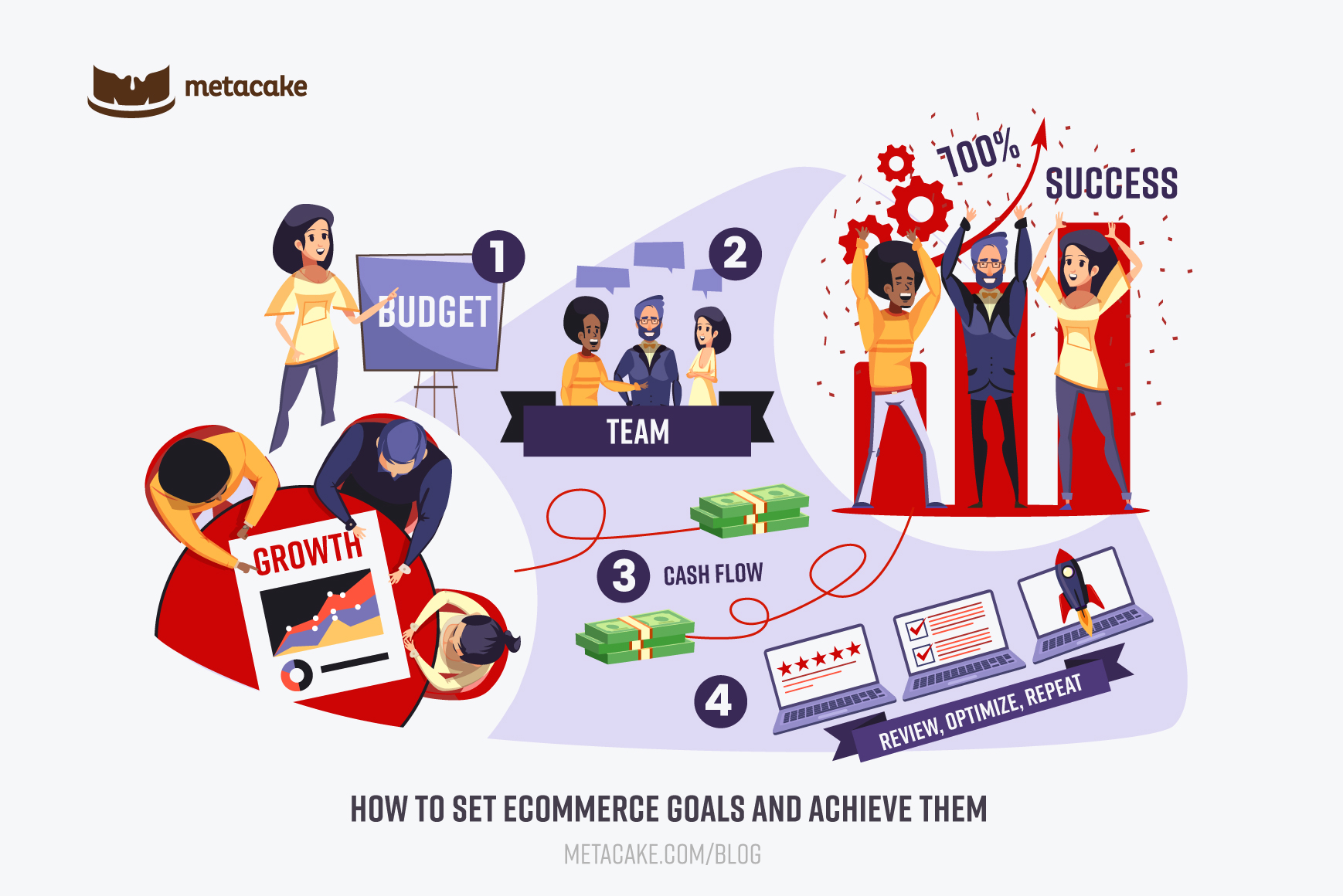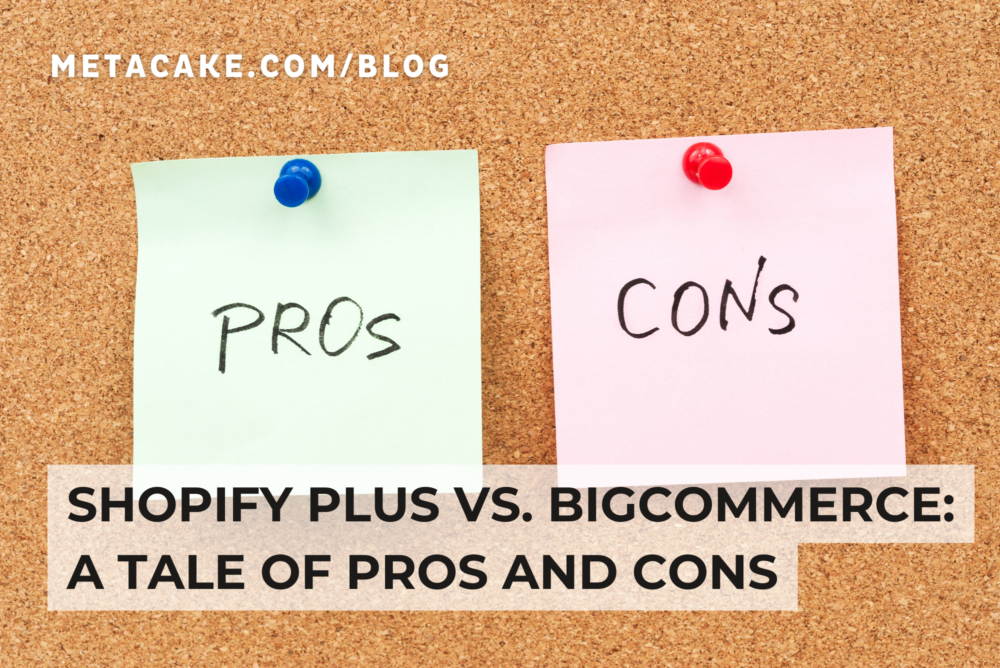
How to Set Ecommerce Goals and Achieve Them
If you are a successful ecommerce company, you should naturally be a goal-setting and goal-crushing machine. Right?
Here at Metacake, we work with ecommerce brands of all sizes, and the truth is many businesses don’t set goals proactively. Oftentimes, businesses are driving while looking in the rearview mirror— setting goals based on the past.
Another scenario that might be worse are goals set arbitrarily by a board of directors or business executives completely detached from the reality of what it takes to achieve those goals. The people who set the goals or are responsible for achieving the goals should have some understanding of how they would be achieved and have some expertise in ecommerce.
In this article, we’re going to show you how we think about goals for ecommerce brands, including how to set and achieve them whether you’re a large global brand, a mid-market, or a hyper-growth brand. We’ll also take a look at how to measure success (important!) and what to do if you feel like you’re not hitting the goals you set.
SMART Goals
When thinking about any goal (not just business goals), you should force yourself to make them SMART. Specific, Measurable, Achievable, Realistic, Timely. Each goal must have these 5 characteristics defined if you have any hope of achieving them.
Change Your Behaviors
The blunt truth is that if you are a person or a company trying to achieve a new goal you will simply not achieve it by using the same mindset and same actions that have taken you to where you currently are. If you want to change your situation you need to change your behaviors.
Types of Ecommerce Goals
There are actually only a few basic categories that most goals boil down to in ecommerce. Inside of these, it’s important to be specific and give yourself a timeline. Let’s take a look at them:
Revenue Target
This is obviously the most common goal and could be set in the form of a multiple (3x our yearly revenue) or percentage growth (300% growth year over year). Whatever you pick, be sure to be very specific.
Product Launch
For merchants who release products all the time, such as clothing retailers, product launches are not a huge deal. However, for some brands, a new product launch could be massive and require a lot of product development. For example, think about Apple launching the Apple Watch. That shook things up and took plenty of planning and resourcing.
Brand Repositioning
This is typically a CPG business or a large global organization looking to modernize their brand and shift toward an opportunity in ecommerce. Again, this requires major planning and resourcing.
Margin (Product and Profit)
By thoroughly investigating your paid marketing, it is possible to decrease your cost per acquisition and maximize your profit margin. However, a healthy product margin is key to a scalable ecommerce channel. Product margin should be a key goal for any ecommerce business.
Steps to Setting an Achievable Ecommerce Goal
The initial step is not overly complicated. Simply set a goal your business would like to achieve, and then back out of it to determine how you will get there. But here’s the key: you or your team must have enough expertise to articulate what it will take to achieve that goal.
Before you do anything else, establish a WHY for your goal. Claiming your “why” is a trendy phrase these days and we talk about it at Metacake a lot, but it’s not fluffy inspiration. It’s mission-critical. You must have conviction and clarity on why you need to achieve this goal as an organization. Your team must understand this as well. If everyone on board does not have a strong “why”, your brand will either not be able to achieve the goal or just bail when it gets difficult.
Once you have established a goal and the “why” behind it, you must commit. Commitment requires thinking through how hard your team is willing to pursue the goal. We recommend thinking through the worst-case scenario and clearly defining when you should abandon the goal for the health of the business. How far are you willing to push it? This way, if a challenge comes up, your team will know to push through until a certain point.
Finally, create a plan for HOW to achieve the goal. What levers will you need to pull to get there? Here are a few things to consider:
- What marketing budget will be required?
- What can you do to increase metrics like lifetime value and average order value?
- How large is your current market? Is there room to grow?
- What product development will be required?
- If your goal is revenue related, have you planned your marketing calendar?
- What optimizations can be done to increase profit margins?
- Can any adjustments be made with your supplier to increase product margins?
- What resources will be required to fund your efforts?
- Do you have the team with the right experience to tackle this goal?
How to Crush Your Ecommerce Goal
Once you have your goal set, here’s a simple 4-step framework for achieving that goal.
1. Budget
In most situations, you won’t be able to hit your goal for free. Be realistic about the budget and investment you’ll need to accomplish this well. Consider your “why” and determine how much your brand is willing and able to invest.
2. Prepare Your Team
Whether your team is entirely internal, or you hire an external organization to help, make sure everyone is organized, in place, and clear on their respective roles in this effort.
Shameless pitch: If you’re looking for an external team, we are growth specialists here at Metacake. We come alongside ecommerce brands to create strategies and implement tactics that will help conquer their business goals. These businesses include global brands looking to reposition and move toward DTC ecommerce, as well as mid-market, hyper-growth brands looking to break through the next ceiling of revenue growth. If you’re interested in learning more, get in touch with us here!
Whether your team is internal or external, make sure they have the skills, experience, and resources required to achieve your goal.
3. Cashflow
The great thing about an ecommerce channel is its ability to quickly cashflow. However, keep in mind this will be a unique investment. If paid marketing is part of your strategy (which it usually is) remember that the budget required isn’t a single check you write; it will be spent in phases and is offset by revenue overtime. However, you should plan to invest in your goal upfront. We often see companies think that if they pay $1 for advertising on day one, they will immediately see $5 in return. If that were true, everyone would be advertising like crazy. This is a unique investment in that you won’t spend everything upfront, but it’s not going to deliver profit on day one either.
4. Review, Optimize, Repeat
In the beginning stages of implementing tactics to achieve your goals, you’ll be working off of a theory for success. Once you start seeing results (or lack of results), you need to be able to adapt to feedback quickly. Marketing conditions are always changing, so your team should review performance, optimize for what’s working and change what’s not consistently. This step is critical, and so many skip over it. Without feedback and adjustment your goal hitting is little more than a gamble. One way to do this well is using conversion rate optimization.
Achieving Success (Or Not)
It’s inevitable: sometimes, you won’t hit your goals. And that’s okay. In fact, if you hit your goals month after month, year after year, we might say that your goals aren’t actually challenging enough. Regardless, it’s important to know how to evaluate success along the way.
We typically measure success based on a positive trajectory toward the goal. Growth doesn’t operate on a consistent velocity— it’s the acceleration (changing speed over time) that matters. Let’s look at what that means practically.
If your goal is to double the business in the next year, you’ll make a plan and implement it. However, the likelihood is that you won’t double revenue right away, month on month. It may take a few months to ramp up. At some point, you will need to assess whether the acceleration you’re experiencing will be enough to get you to the goal. But falling short of the goal is not necessarily a failure. If that’s the case, determine whether you’re at least on the path toward hitting the goal. Does your trajectory show speed moving in the right direction?
If you’re looking to hit a revenue goal, that will definitely take time. We have seen brands experience mediocre results for the first few months of implementation and jump ship. Giving up that early is not the answer! If you’re not losing money and things are at least moving in the right direction, give it six to 12 months before calling it quits.
The Unique Nature of Goal Setting in Ecommerce
As you’re goal-setting, planning, and implementing, keep in mind the unique nature of ecommerce. Ecommerce goal-setting is different than any other type of business because you will see the results of your day-to-day activities immediately. Most businesses don’t get that luxury. Most won’t see results of campaigns or initiatives for months or years down the road. Take advantage of the benefit of instant feedback and use it to constantly be measuring, tweaking, optimizing, and adjusting your plans and tactics for success.
Take Action
What are your goals for this year? If you have not thought it through, or if you have a goal in mind but no idea how to get there, we’re here to help! We specialize in guiding global brands as well as new, hyper-growth brands on the right path to hitting their business goals. Click below to get in touch with us today.


